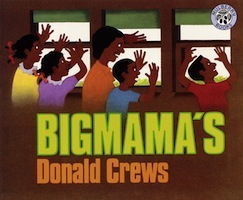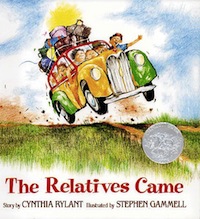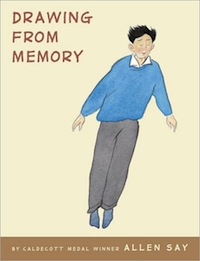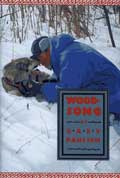Author & Illustrator Studies
![]()
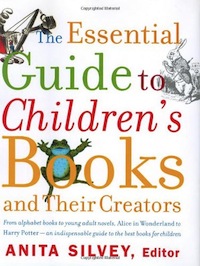
First of all, a treasure--The Essential Guide to Children's Books and Their Creators, edited by Anita Silvey (Find this book: Local Bookstore, Amazon, B&N). Information about the lives and work of many, many children's authors and illustrators are arranged alphabetically in this tome. Included in the same alphabet are articles about illustration, non-fictional books, biographies, folklore and the like and many offer useful information, but the most wonderful parts of this book are the brief articles by many of the authors and illustrators themselves. These leap off the page with the exuberance, frankness and vulnerability of these talented people. Trina Schart Hyman, for instance, ends the article in which she has described the way she illlustrates her books with these words:
"I know that my illustrations are often criticized for being overblown, over the top, too sensuous, too prettified, too scary, too old-fashioned, too emotional, too obvious, too subjective, and otherwise excessive and immoderate. And I think that's absolutely right."
Sid Fleischman, after eschewing outlining and advance plot and character summaries, says,
"If I knew everything in advance, I'd find it tedious to sit at my desk for hours each day scratching out the story. Instead, I'm at my desk fifteen minutes after I get out of bed in the morning; I can't wait to find out what's going to happen next in the novel. I am audience as well as author."
With these author entries as inspiration, let's look at the words of authors and illustrators when they talk about themselves as lead-ins or follow-ups to their work and as inspiration for younger authors and illustrators. The theme can be a lead-in to biography or a source of inspiration and instruction on writing itself.
Choose one or two of the pieces from this book or from other sources in which the artists speak for themselves to the kids. Refresh your students' memories by displaying and talking about a few of the author/illustrator's books first. Let the kids remind each other of some of the plots or characters in their favorites. Then read your selection of an author/illustrator talking about their life or work. Afterwards look together at some of that artist's work. Do you notice things you didn't see before? Do any of you ever work that way? Could you? What suggestions or insights about creating are there? Are there ideas you might try?
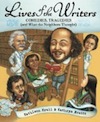 A good collective biography about authors is Lives of the Writers: Comedies, Tragedies (and What the Neighbors Thought) by Kathleen Krull (Local Bookstore, Amazon
A good collective biography about authors is Lives of the Writers: Comedies, Tragedies (and What the Neighbors Thought) by Kathleen Krull (Local Bookstore, Amazon, B&N). There are 20 different authors, mostly writing for adults, whose lives and portraits are included here with a light touch. Shakespeare, the Bronte sisters, Twain, E. B. White and more.
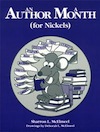 Another treasure is Sharron L. McElmeel's An Author a Month (for Nickels) (Local Bookstore, Amazon
Another treasure is Sharron L. McElmeel's An Author a Month (for Nickels) (Local Bookstore, Amazon, B&N). There are photographs and brief biographies of many authors here as well as some logical, practical activities for libraries and classrooms.
If you and the students are interested, go further. Start a couple of bulletin boards, one labeled HINTS FROM THE GREATS and the other THEIR BOOKS. On the first, let readers post amusing, touching or insightful quotes or suggestions about writing from the artists. On the other, put photographs of the artists and book covers of their work.
Pull out some of the best of the author autobiographies like The Moon and I by Betsy Byars (see below). (She writes title pages first.) Read aloud the chapter where she finds the dead snake by the side of the road. It's one of the funniest scenes in children's literature.
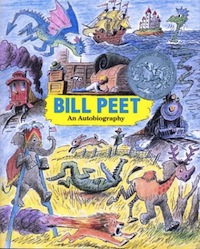
Bill Peet: An Autobiography (Local Bookstore, Amazon, B&N) is very accessible reading and brings the artist and his work into a new light.
The whole Meet the Author series by Richard C. Owen Publishers is wonderful. My favorite is Best Wishes by Cynthia Rylant (Local Bookstore, Amazon, B&N), but they're all great, easily accessible to immature readers, but interesting to a wide range of students and are chock-full of color photographs of the authors.
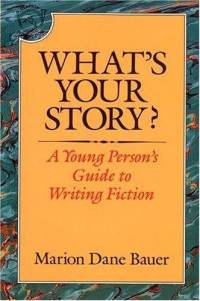 Some of the best author information is available as picture books. Donald Crews' Bigmama's (Local Bookstore, Amazon
Some of the best author information is available as picture books. Donald Crews' Bigmama's (Local Bookstore, Amazon, B&N) is autobiographical and makes a nice contrast to Cynthia Rylant's The Relatives Came (Local Bookstore, Amazon
, B&N).
Some authors have written directly to young writers with advice about the craft. Particularly outstanding is Marion Dane Bauer's What's Your Story: A Young Person's Guide to Writing Fiction (Local Bookstore, Amazon, B&N).
It's interesting to read both an autobiography and a biography of the same author if you can find one of each. In which book do students see the author most clearly?
Everyone likes getting mail and authors are no exception, especially if the letters come at the reader's rather than the teacher's direction, so encourage any who so desire to write to their favorite authors. Sometimes you can write to them through their web sites. You can also write to an author in care of their most recent publisher. You can get an author's most recent publisher's name and address by calling the reference librarian at your nearest city library.
Of course, through all this, your aim is to encourage discussion and reading, not only the books about the authors but the books they have written as well. Bigger questions then present themselves: Are there common themes? characters? plot devices? techniques? Looking at this author/illustrator's life and work, what could he/she be trying to tell us?
![]()
Related Books
![]() Grades 2 - 9
Grades 2 - 9
The Art of Eric Carle by Eric Carle. Nonfiction. 128 pages.
Find this book: Local Bookstore, Amazon, B&N
This is a wonderful source book for information about Eric Carle and his work. Carle includes a delightful autobiography amply illustrated with photographs and sketches but there is much more in the book. An editor relates her experiences with Carle. There's a section about the way he creates his work and writings both by Carle and some of his colleagues. Best of all, the book is a compendium of his artwork.
![]() Grades 4 - 9
Grades 4 - 9
The Moon and I by Betsy Byars. Nonfiction. 112 pages.
Find this book: Local Bookstore, Amazon, B&N
With a light and humorous touch, Ms. Byars tells of the way she writes her books. Throughout the account, she also tells of her very funny relationship with a snake, Moon, which she found near her cabin. Her need to learn more about snakes in general and Moon in particular became an obsession that, for a brief time, dominated her existence. That obsession, the reasons for it, and the ways in which she conducted her research are so interesting and helpful that you'll want to read the brief book aloud at the outset of a research project. Read More.
![]() Grades K - 2
Grades K - 2
Bigmama's by Donald Crews. Picture Book. 40 pages.
Find this book: Local Bookstore, Amazon, B&N
Bigpapa and Bigmama both live in the white farmhouse in Cottondale, Florida where the author spent his summers as a boy, but they called it Bigmama's. When he and his family arrive they dash about exploring the farm checking everything. First the house and everything in it from fireplace to treadle sewing machine, then the porch, yard and outbuildings. The family's exuberance at being together is what comes through in this book as does an African American family's farm sixty years or so ago.
![]() Grades 1 - 4
Grades 1 - 4
The Relatives Came by Cynthia Rylant. Illustrated by Stephen Gammell. Picture Book. 32 pages.
Find this book: Local Bookstore, Amazon, B&N
This is less a story than a description of a wonderful family reunion. The relatives drive all the way from Virginia, drinking pop and eating crackers and observing the terrain before they literally drive into our yard (knocking down the fence as they do so). From that moment on they eat, sleep, hug, fix things, take pictures, sing and play instruments and celebrate being together with not much in the way of material things, but a great deal of love. Read More.
![]() Grades 4 - 9
Grades 4 - 9
Drawing from Memory by Allen Say. Nonfiction. 72 pages.
Find this book: Local Bookstore, Amazon, B&N
In 1937 near Tokyo, Japan, Allen Say was born to parents who didn't understand his passion for drawing. "When I was drawing, I was happy. I didn't need toys or friends or parents." His parents, especially his father, thought that artists were lazy and scruffy. They expected him to stop drawing, even as a child, and focus on preparing himself to earn a respectable living. Read More.
![]() Grades 5 - 8
Grades 5 - 8
Alida's Song: A Companion to The Cook Camp by Gary Paulsen. Novel. 88 pages.
Find this book: Local Bookstore, Amazon, B&N
Alida is the grandmother in The Cookcamp (Orchard, 1991 ISBN 0531085279). In Alida's Song, that grandmother rescues him again. She's not working in the cookcamp now but is housekeeper and cook for two bachelor farmers. She writes asking her grandson to join her. He will, she says, be able to help with the farming. The book is tender and quite wonderful. The knowledge that the work is largely autobiographical lets us feel grateful that the man whose work we so admire today had such nourishment, at least for a summer. Read More.
![]() Grades 3 - 9
Grades 3 - 9
Woodsong by Gary Paulsen. Novel. 144 pages.
Find this book: Local Bookstore, Amazon, B&N
These are autobiographical sketches of Paulsen's experiences in the north woods. There is acceptance and respect for animal life, especially sled dogs, in all its harsh reality. A good portion of the book relates the author's experiences in running the Iditarod. These are good adventure and outdoor stories which should appeal to outdoor enthusiasts and to animal lovers. Read More.
![]()
Related Areas of This Site
- Author Studies
A listing of all our classroom individual author and illustrator study articles.
Advertisement:
Advertisement:
Advertisement:


